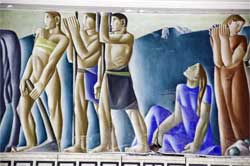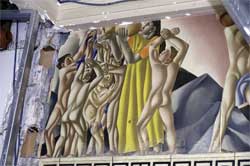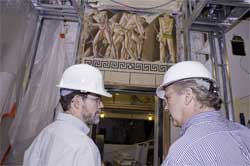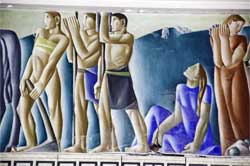KINGSTON, R.I. – August 9, 2010 – Seventy-one years ago during the Great Depression, Providence artist Gino Conti completed his final set of mural paintings for the lobby of Edwards Hall at Rhode Island State College.
But until just two weeks ago at what is now the University of Rhode Island, no one knew that Conti’s murals had survived renovations that kept them hidden for 43 years.
 As a $1.5 million summer project to enhance fire protection, technology and aesthetics in the auditorium building progressed, workers with Calson Corp. of Johnston discovered the murals in the Edwards lobby. They sought the expertise of the library staff and the Art Department, which then called the University’s Business Services and Capital Projects offices.
As a $1.5 million summer project to enhance fire protection, technology and aesthetics in the auditorium building progressed, workers with Calson Corp. of Johnston discovered the murals in the Edwards lobby. They sought the expertise of the library staff and the Art Department, which then called the University’s Business Services and Capital Projects offices.
Now, the University is taking steps to remove and protect the artwork so the building’s renovation work can be completed in time for the start of classes in September. The 900-seat auditorium is used for large classes and this year will be home to the URI Honors Colloquium on race.
Beginning today, Aug. 9, a two-person team from the Williamstown Art Conservation Center in Williamstown, Mass., which has been hired by the University, will begin removing the murals for conservation.
Thomas Branchick, director and conservator of paintings at Williamstown, expects to take two days to remove the artwork.
Branchick said he is encouraged that the oil-on-canvas paintings are attached to the walls with wallpaper paste.
“The nice thing about that kind of adhesive is that it desiccates with time, meaning it will be very brittle. That will allow us to insert a spatula or some other cutting piece of metal that will allow us to shear the adhesive between the fabric and the wall.
“In the best-case scenario, putting them on panels is probably what I would advocate because they would be portable in the future.”
He said they are dusty because of the construction, but they will be cleaned, which will substantially improve their clarity.
 “If they do go on panels, I would recommend a fabric interleaf and a varnish coat that would make the color a little more intense,” Branchick said.
“If they do go on panels, I would recommend a fabric interleaf and a varnish coat that would make the color a little more intense,” Branchick said.
For URI Professor Ron Onorato, an art historian who wrote a paper in the early 1980s titled, Rhode Island’s WPA Art, the discovery is great news. His paper addresses the sad history of many works of art from the Depression era: “Many, like the projects for Edwards Hall at the University of Rhode Island (then called State College at Kingston)… have been painted out, destroyed or otherwise lost.”
Like thousands of other artists who struggled to find work during the Great Depression, Conti benefited from the New Deal program of the Works Progress Administration, established in 1935, and renamed the Work Projects Administration in 1939. Now in 2010, the American Recovery and Reinvestment Act, designed to lessen the suffering of what many have called the worst economic crisis since the Depression, is responsible for the discovery of Conti’s murals.
Thomas Frisbie-Fulton, URI’s director of Campus Planning and Design, said the work was probably commissioned during the 1930s. He said the murals were uncovered in mid-July by the contractor.
“We were very excited to see the uncovering of the works and further to learn they are of a Providence based artist whose family moved to Rhode Island in the very early 1900s,” Frisbie-Fulton said. “Our work since uncovering the murals has been to isolate them and protect them from the ongoing construction.”
He said the goal is to return them to the same general space in Edwards.
Even though sections of the paintings have been damaged by framework that was nailed to the murals, and some pieces are torn at the corners, the images remain remarkably colorful and powerful.
According to the March 16, 1941 Providence Journal, “Of the two largest panels, one symbolizes the drama, music and the dance; the other the protection of youth; the striving for progress and the past. Four smaller canvasses depict the elements with groups of figures symbolizing water, fire, air and workers in the soil.”
In January 1940, Samuel M. Green, the supervisor of the Rhode Island Art Project, wrote to Rhode Island State College President Raymond G. Bressler about murals for Green Hall and Edwards Hall. The Green Hall murals, done by a different artist, have never been found. In asking President Bressler if he wanted to see Conti’s murals for Edwards while they were in the studio, Green said the works in progress consisted of the “remaining panels for the foyer of the auditorium by Mr. Conti, the decorations on either side of the stage and the bust of former President Edwards.”
Art Professor Onorato said post offices, school buildings and university buildings were often home to federally funded arts projects during the Depression.
“To have this reappear adds to the relatively small number of works that exist on walls from the period,” Onorato said. “To have these in place for so long, we are lucky. Many of these types of pieces have been lost all around the country.
“Sometimes the subject matter is very specifically Americana or colonial revival,” Onorato said. “These are more allegorical scenes. They have to do with progress, education, larger concepts. The artist was born in Italy and went to the Rhode Island School of Design.”
 “The (Edwards Hall murals) are classically inspired,” Onorato said. (Conti) was looking at European work; he went to Europe a number of times, and also examined the famous Mexican muralists in the 1930s. These murals are about values.”
“The (Edwards Hall murals) are classically inspired,” Onorato said. (Conti) was looking at European work; he went to Europe a number of times, and also examined the famous Mexican muralists in the 1930s. These murals are about values.”
When Onorato had the chance to interview Conti in the late 1980s just before he died, Conti commented on how interested he was in education and the values that can be imparted in education.
ASSESSING HISTORIC ARTWORK: Thomas Frisbie-Fulton, URI’s director of Campus Planning and Design, left, and Thomas Branchick, director and conservator of paintings at the Williamstown Art Conservation Center in Williamstown, Mass., discuss one of the murals in Edwards Hall. URI Department of Communications & Marketing photo by Michael Salerno Photography.

